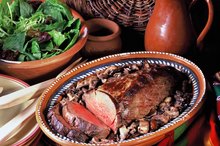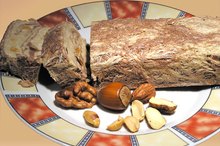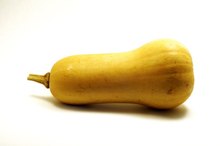Acorn Squash Nutrition Information
The acorn squash is a variety of the squash species Cucurbita pepo, which also includes pumpkins and zucchini. It’s a winter squash, meaning that you typically eat it in the winter when the fruit is fully mature. The acorn squash generally has an acorn-like shape and is typically dark green.
Preparation and Serving Size
The nutritional content of acorn squash is similar to that of all other varieties of squash. It applies specifically to baked winter acorn squash that doesn’t contain any additional salt. The serving size is 1 cup of cubed acorn squash weighing 205 grams, or about 7.25 ounces.
Calories
Baked Haddock Nutritional Values
Learn More
A serving of acorn squash contains a total of 115 calories. Carbohydrates contribute 107 calories, fat accounts for 2 calories and proteins provide the remaining 6 calories. A serving of acorn squash provides less than 5.8 percent of the daily value (DV) for calories, based on a daily diet of 2,000 calories.
Carbohydrates
A serving of acorn squash contains a total of 29.9 grams of carbohydrates, or about 10 percent of the DV for total carbohydrates. This includes 9 grams of dietary fiber, which is about 36 percent of the DV for dietary fiber. A serving of acorn squash doesn’t contain any simple sugar.
Fat and Protein
Pot Roast Nutrition
Learn More
A serving of acorn squash contains 0.3 total grams of fat, which is less than 1 percent of the DV for total fat. Acorn squash contains 0.1 grams of saturated fats, which provides less than 1 percent of the DV for saturated fats. Acorn squash doesn’t contain any trans fat or cholesterol. A serving of acorn squash also has 2.3 grams of protein, which is about 5 percent of the DV for protein.
Vitamins and Minerals
A serving of acorn squash contains 37 percent of the DV for vitamin C, 23 percent of the DV for thiamin and 20 percent of the DV for vitamin B6. It also contains 18 percent of the DV for vitamin A, 10 percent of the DV for folate and 10 percent of the DV for pantothenic acid. A serving of acorn squash contains 26 percent of the DV for potassium, 25 percent of the DV for manganese and 22 percent of the DV for magnesium.
Related Articles
References
Writer Bio
Allan Robinson has written numerous articles for various health and fitness sites. Robinson also has 15 years of experience as a software engineer and has extensive accreditation in software engineering. He holds a bachelor's degree with majors in biology and mathematics.









